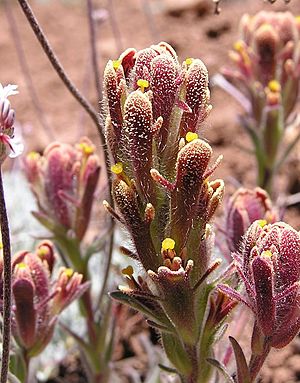Ashgray Indian paintbrush facts for kids
Quick facts for kids Ashgray Indian paintbrush |
|
|---|---|
 |
|
| Conservation status | |
| Scientific classification | |
| Genus: |
Castilleja
|
| Species: |
cinerea
|
Castilleja cinerea is a special kind of Indian paintbrush flower. It's also known as the ashgray Indian paintbrush. This plant is found only in one small area: the San Bernardino Mountains in San Bernardino County, California. There are only about 20 known groups of these plants left.
What is the Ashgray Indian Paintbrush?
This plant is a perennial herb. This means it's a small plant that lives for more than two years. It grows up to 15 centimeters (about 6 inches) tall. The plant is covered in soft, gray, woolly hairs.
Its leaves are long and narrow. They are about one or two centimeters long. The flowers grow in a cluster called an inflorescence. This cluster has fuzzy, dull to bright reddish or purplish-pink leaves called bracts. The actual flowers are smaller and yellowish to greenish.
The color of the flower cluster can change. Plants facing north often have yellowish flowers. Those facing south tend to have more reddish flowers.
Like other Castilleja plants, this one is a parasitic plant. This means it gets water and nutrients from other plants. Castilleja cinerea often taps into buckwheats (Eriogonum species) and sagebrushes (Artemisia species).
Where Does it Live?
Castilleja cinerea grows in different places. It can be found in dry desert areas and sagebrush scrub. It also lives in woodlands and coniferous forests.
This plant is also found in a special habitat. This unique place is called a quartzite pebble plain. It shares this home with other rare plants, like Arenaria ursina.
Why is it in Danger?
The Castilleja cinerea plant is a federally listed threatened species. This means it is protected by law because it is at risk of disappearing.
Many things threaten its survival. These include:
- Building homes and other structures in its habitat.
- Outdoor activities like recreation and off-road vehicles.
- Cutting down trees (logging).
- Animals eating the plants (grazing).
- Mining activities.
- Invasive species of plants that take over its space.


